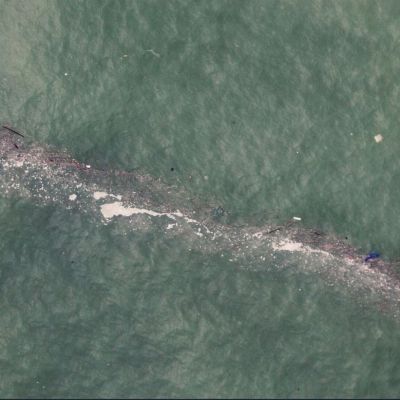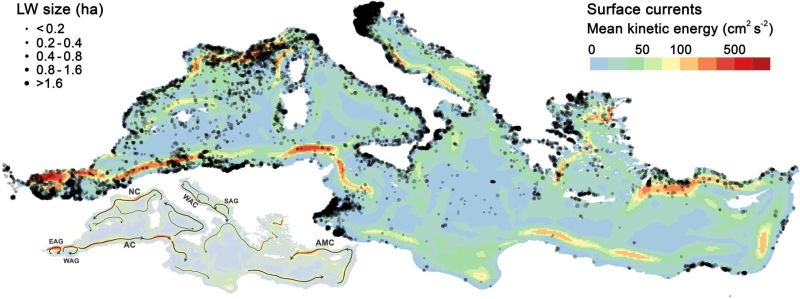
Recently ESA published the results of a proof-of-concept study into monitoring marine litter using existing satellites, with promising results for the Mediterranean study area. For the study, six years of historical data from the Sentinel-2 satellite multispectral imaging cameras were used, involving 300,000 images with a resolution of 10 meters. The focus was on litter windrows as common collections of litter like plastic, wood and other types of marine debris that float on the surface, forming clearly visible lines that can be meters wide and many times as long.
These were processed as explained in the open access paper in Nature Communications by [Andrés Cózar] and colleagues. As marine litter (ML) tends to be overwhelmingly composed of plastic, this eases the detection, as any ML that’s visible from space can generally be assumed to be primarily plastic litter. This was combined with the spectral profile of common plastics, so that other types of floating materials (algae, driftwood, seafoam, etc.) could be filtered out, leaving just the litter.
This revealed many of these short-lived litter windrows, with spot confirmation from ships in the area. Some of the windrows were many kilometers in length, with an average of around 1 km.
Although just a PoC, it nevertheless shows that monitoring such plastic debris from space is quite doable, even without dedicated satellites. As every day tons more plastics make their way into the oceans, this provides us with the means to at least keep track of the scope of the problem. Even if resolving it and the associated microplastics problem is still a far-off dream.
















Skimmers make sense if this stuff forms strips. Real-time data and a robot could get a lot.
Skimmers make sense if they are Chinese and there are a LOT of them.
neat!… but also horrifying that there is so much plastic in the oceans.
Yes, it’s HORRIFYING… until you investigate rather than buying the typical hype.
I used the total plastic figures in this scary article:
World-First Study Reveals That There Is up to 100x More Plastic on the Ocean Floor Than the Surface
12 Apr 2024
to calculate this:
1.111^7 metric tons total plastic mass / 1.3137261^18 metric tons total ocean mass = 8.4568485^-12
So, the total plastic mass is 1/8,456,848,500,000 or 8.457 quadrillionths of the total ocean water mass or 0.0000000008457% by weight.
And the -VAST- majority of photos you see of the Pacific Garbage Patch are of rivers and river outlets in Asia, mainly China and India.
Here’s a photo of the ACTUAL patch being cleaned up:
https://assets.theoceancleanup.com/scaled/1200x/app/uploads/2023/11/Medium-231019-Meetingday-06.jpg
“Microplastics make up 94 percent of an estimated 1.8 trillion pieces of plastic in the [Pacific garbage] patch. But that only amounts to eight percent of the total tonnage. As it turns out, of the 79,000 metric tons of plastic in the patch, most of it is abandoned fishing gear—not plastic bottles or packaging drawing headlines today.”
If you want to fear plastics, this MIGHT be concerning and its NOT coming from the ocean:
Experiment Reveals Microplastics in Every Human Semen Sample Tested
15 June 2024
Microplastics Found in Every Human Testicle Examined in New Study
21 May 2024
The new research published in the journal Toxological Sciences saw professor Yu and his colleagues analyze 47 canine testicles sourced from neutered animals and 23 human testes that had been anonymously obtained from donors through the New Mexico Office of the Medical Investigator.
It was discovered that every single one of the testicles examined during the study contained a significant amount of microplastics. The human testicles in particular contained an abundance of the pollutant (329.44 micrograms), which was three times higher than the average microplastic content of the average canine testicle (122.63 micrograms). A grand total of 12 different microplastics were found in the reproductive organs, with the most common being the polymer polyethylene, which is used in the creation of plastic bottles.
Discarded/lost fishing gear, and the pointless killing of marine life that it causes, doesn’t horrify you? And plastic in the ocean can easily make its way into our food chain. Do you eat seafood?
To the commenter pointing to the pollution from the east – remember that much if not most of the plastics they manufacture or handle are for us in the west.
if you have ever been fishing (from sport to commercial) you know that gear loss is practically unavoidable. the ocean is essentially liquid hate and it wants you dead and your vessel on the bottom.
Commercial nets should be labeled and registered, maybe even with tracking devices, and fleet owners should bear the cost of recovery and disposal of lost/discarded nets. At a minimum, there would be less incentive to just abandon old or broken gear.
A longshot I know, but we will all end up paying for continued neglect in any case.
KenN Another law will stop the Chinese world wide fishing fleet? China consider any vessel registered in China to be part of their Navy and they don’t acknowledge territorial waters and World Heritage zones like the Galapagos. This week they are boarding and ramming Philippine boats with swords and spears and axes (!) as China claims the entire South China Sea. They still do the long ocean drift nets up to 20km in length and lose them when they are run over by a freighter or naval vessel. Every solution I read in the comments fails in the face of the CCP and SEA countries.
fishing gear is expensive. nobody likes to lose it. nobody wants to lose it, but the sea is harsh and things can happen quickly. we can regulate and hold accountable, but what would that serve. and beacons dont exactly have infinite range. very little cell coverage at sea. you can regulate fishing all you want, it only hurts the little guys. the mcdonalds factory trawlers are still overfishing just to end up pressing perfectly good fish into inedible squares to put on their filet’o’fish sandwiches.
Tell me you don’t understand bioaccumulation without saying that you don’t understand bioaccumulation using the largest possible amount of pointless text.
And from the ground we can monitor litter in space!
Lol
We know where it comes from, a handful of rivers. I don’t see the point of this except to someday direct a fleet of cleaning vessels. I mean wessels.
If you have data you can influence decision-making in politics, which can influence laws and enforcement to reduce pollution.
By far the majority comes from China. Good luck with data versus the CCP. https://www.scientificamerican.com/article/stemming-the-plastic-tide-10-rivers-contribute-most-of-the-plastic-in-the-oceans/
There’s plenty wrong with western practices; those need to be addressed regardless of “oh, but China!!!”. The west is still China’s best customer.; they’re making a mess while making our stuff for cheap, catching fish for us, etc.
If you can not blame the ones who actually dump garbage in their own rivers I don’t see where you go next.
What Western practices are dumping plastics in the oceans? Maybe you mean Western like Honduras or Mexico?
Oh look, the US blames China.. how surprising and now doubt 100% reliable..
Feel free to have environmental anxiety in the West, the do whatever they want in the East.
Yah, no shit. Which is why the west needs to encourage the east to work on the problem too. It’s not a logical excuse to do nothing and just let the problem grow.
If you were about to throw the first and only piece of trash into the ocean but changed your mind that’s one less piece of trash in the ocean. If 99 other people were doing the same but you decided not to that is still one less piece of trash than if you went through with it.
What did you hope to accomplish by pointing this out?
Have you found a way to influence the Communist Part of China? Curious people want to know.
You really think they have zero desire to trade with Western nations that can be exploited for such purposes?
But even if there was no way to influence them… so what? How does that give anyone an excuse to become more a part of the problem?
It isn’t about excuses. It is about efficacy. My town on Puget Sound has banned plastic grocery bags. The really thin ones that people use for waste basket liners and a dozen other things after the groceries are home. They banned them because they kill sea turtles in the Indian ocean. Now, we have full garbage and recycling collection and it goes to a land fill. Nobody from here is dumping their grocery bags in the Indian ocean. The town has no metric for determining if the law had any effect. In fact it is know to have increased the amount of plastics being bought because now people by bags for waste basket liners and such and they are all 3 or 4 times thicker than the grocery ones.
Anyway, how are the people of the town part of the problem? Buying cheap goods from China in no way forces Chinese to dump their own water bottles and bags and trash in the rivers and oceans. And implying that the customers are a cause does not seem rational at all.
needlessly edgy yet general “West bad” take plus “go ahead, click the website link” – it’d say it’s a bait.
Who are we even talking about. Take India for example, there’s the Bharat Clean
Rivers Foundation who partnered up with The Ocean Cleanup (who contributed to the research mentioned above) to tackle riverine plastic waste: https://bharatcleanrivers.com/
So, looking at that map on the site I conclude: Guilty party = everybody, a lot from Nice(France) and seemingly low from Turkey and very low from Israel? Who knew.